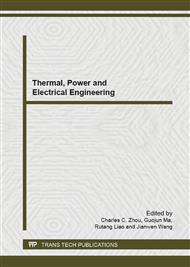p.495
p.501
p.509
p.513
p.527
p.531
p.537
p.541
p.548
Thermodynamic Analysis of a R32/CO2 Cascade Refrigeration Cycle
Abstract:
A R32/CO2 cascade refrigeration cycle was analyzed thermodynamically, the results show that: Under given working conditions, there exists the best condensing temperature of the low-temperature circuit to make the maximum COP of the cycle. The lower evaporating temperature is, the lower the best condensing temperature of the low-temperature circuit is. Under the same evaporating temperature, COP increases and mH/mL decreases along with condensing temperature decreasing, under the same condensing temperature, COP decreases and mH/mL increases along with condensing temperature decreasing. To reduce the temperature difference in the cascade-condenser can increase COP and decrease mH/mL.
Info:
Periodical:
Pages:
527-530
Citation:
Online since:
August 2013
Authors:
Price:
Сopyright:
© 2013 Trans Tech Publications Ltd. All Rights Reserved
Share:
Citation:


